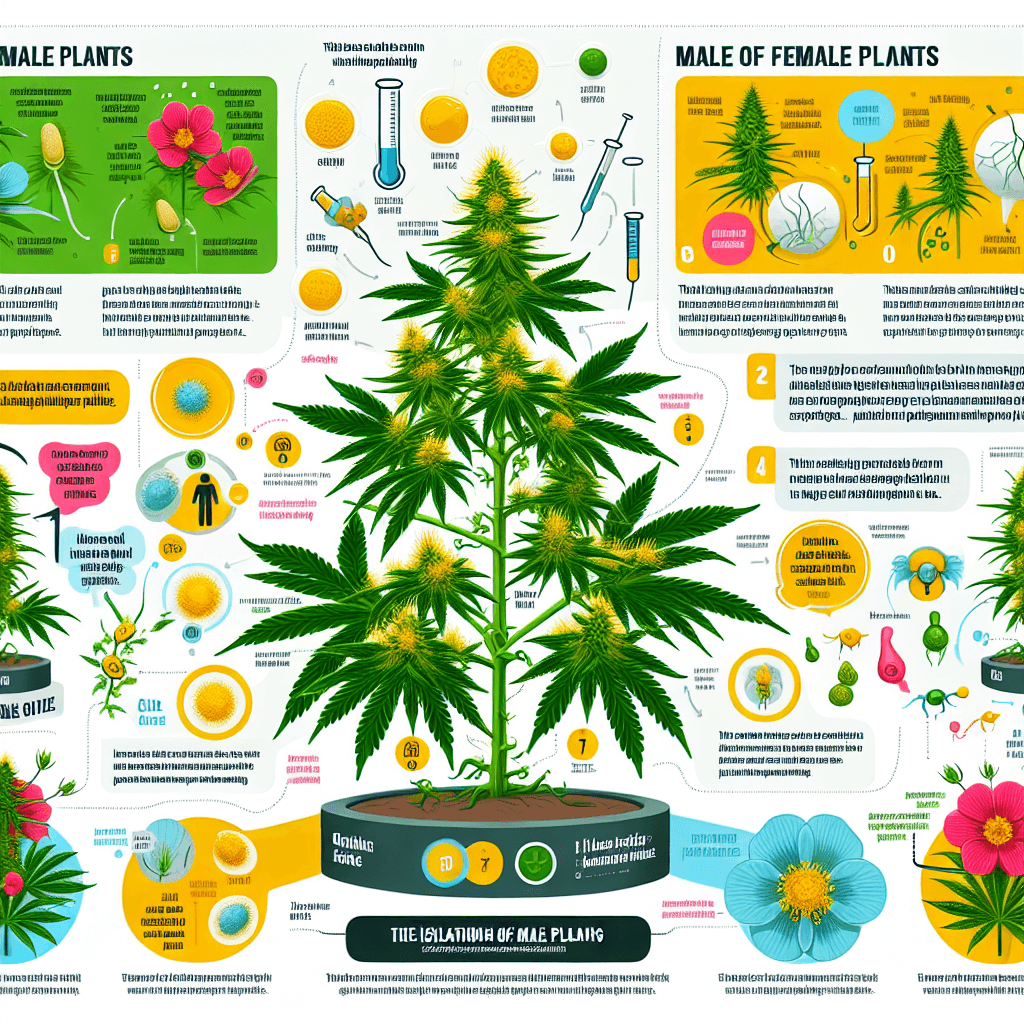How To Pollinate Marijuana Plants 101
Pollinating cannabis plants is an essential technique if you’re interested in breeding new strains or producing seeds for future planting. Here’s a simple step-by-step guide on how to pollinate cannabis plants:
1. Identify Male and Female Plants
First, you need to identify the male and female cannabis plants. Male plants produce pollen sacs, while female plants produce buds that are the actual flowers.
2. Isolate Male Plants
Once you identify a male plant, you should isolate it from the female plants if you don’t want all your females to be pollinated. Pollen can travel long distances on air currents, so even a small amount of exposure can result in pollination.
3. Collect Pollen
When the male’s pollen sacs begin to crack and look like they’re about to open, place a small bag (such as a zip-lock or paper bag) over the pollen sac cluster and tie it around the stem to collect the pollen as the sacs open. You can also carefully cut the pollen sacs and dry them in a paper bag. Once dried, shake the bag gently to release the pollen from the sacs.
4. Pollinate Female Plants
Using a small brush or even your finger, take some of the collected pollen and gently apply it to the pistils (the tiny hair-like strands on the female buds) of the female plant. These pistils are where the seeds will develop. It’s best to do this when the plant is in its flowering stage, about two to three weeks into the cycle.
5. Mark Pollinated Plants
It’s important to mark the pollinated plants or branches to keep track of your breeding and results.
6. Wait for Seed Development
After pollination, seeds will begin to form and mature within the buds of the female plants. This process typically takes about 4 to 6 weeks. Once the seeds are mature, the surrounding bud will usually dry out and you can harvest the seeds.
7. Harvest and Store Seeds
Carefully collect the seeds, remove any plant material, and store them in a cool, dry place inside an airtight container. Properly stored cannabis seeds can last for several years.
Safety Tips:
- Always handle cannabis plants, especially when they are flowering, with care to avoid damaging the buds.
- When dealing with pollen, be aware that it can be highly allergenic and irritant. Wearing gloves and a mask can help prevent any allergic reactions.
Pollinating cannabis plants can be a rewarding experience if you’re interested in genetics and breeding. It gives you the opportunity to develop unique strains and ensure a continuous supply of seeds.
When pollinating cannabis plants, especially with the intention of breeding new strains, genetic crossing and gene pool variations are critical concepts. These factors determine the diversity of traits in the offspring, which can include differences in plant size, bud structure, potency, flavor, and resistance to diseases and pests.
Genetic Crossing
Genetic crossing refers to the mixing of genes from two different plants (one male and one female) to produce offspring with a combination of traits from both parents. This is the basis of breeding programs aimed at enhancing certain desirable traits or developing entirely new strains. Here’s what to consider:
- Dominant and Recessive Genes: Traits can be dominant or recessive, affecting how likely they are to appear in the offspring. When planning crosses, it’s important to understand which traits might dominate and which might require recessive pairing to show up.
- Hybrid Vigor: Often in the first generation of a cross (F1 generation), hybrids exhibit greater vigor and sometimes improved characteristics compared to their parents. This is known as heterosis or hybrid vigor.
Hybrid vigor, or heterosis, is a fascinating phenomenon in plant breeding, including in cannabis cultivation. It refers to the occurrence where the first generation (F1) hybrids of genetically diverse parent strains exhibit better or more desirable traits than either parent. This can include increased growth rate, yield, resilience, and sometimes even potency and flavor, depending on the traits of the parent strains.
Why Does Hybrid Vigor Occur?
Hybrid vigor results from the combination of genes from two genetically distinct parents. This genetic diversity can lead to an increased ability of hybrids to cope with various environmental stresses and diseases compared to their inbred parents. Here’s how it works:
- Gene Complementation: In F1 hybrids, genes from each parent can complement each other. If one parent has a recessive detrimental gene, the dominant healthy gene from the other parent can mask its effect, leading to a healthier and more vigorous plant.
- Increased Genetic Diversity: The mixing of genes from different gene pools increases genetic diversity within the offspring. This diversity can manifest as enhanced physiological and developmental processes, such as faster growth and greater resistance to environmental stresses.
Increased genetic diversity is a key principle in the breeding of many plants, including cannabis, where it plays a crucial role in improving various traits of the offspring. Here’s a deeper look at how this diversity benefits plant breeding:
Benefits of Increased Genetic Diversity
Genetic diversity is the total number of genetic characteristics in the genetic makeup of a species. In cannabis breeding, increasing this diversity has several benefits:
- Enhanced Growth and Vigor: Genetic diversity often leads to better overall growth and vigor. Diverse genetic backgrounds mean that offspring have a greater pool of genes to draw from, potentially leading to combinations that enhance growth speed and overall plant health.
- Resistance to Environmental Stresses: Diverse genetic traits can contribute to a plant’s ability to withstand stresses such as drought, extreme temperatures, and poor soil conditions. Each parent may contribute genes that help the plant manage different stresses, making the offspring more adaptable and robust.
- Disease and Pest Resistance: A genetically diverse plant population is less likely to be decimated by disease or pests because different plants will be susceptible to different threats. This variability makes it harder for a single pathogen or pest to affect the entire crop.
- Improved Yields: Often, plants with a diverse genetic background can produce higher yields. This can be due to a combination of enhanced growth vigor, better nutrient uptake efficiency, and greater resilience against environmental challenges.
- Phenotypic Variability: With increased genetic diversity, there’s a wider range of physical traits (phenotypes). This variability is advantageous for breeders looking to select specific traits to enhance or combine in future generations.
Implementing Strategies to Increase Diversity
To maximize the benefits of genetic diversity in cannabis breeding, breeders often employ several strategies:
- Crossing Diverse Strains: Breeders choose parent plants from different strains or genetic backgrounds. For example, crossing a plant known for its high THC content with another that is resilient to mold might aim to produce offspring that inherit both traits.
- Open Pollination: Allowing plants to be pollinated naturally by the wind or insects can introduce new genetic material from a broader range of paternal sources, although this method offers less control over the resulting genetic makeup.
- Preserving Heirloom and Landrace Strains: These strains are often more genetically diverse than modern, highly-bred varieties. Incorporating these into breeding programs can introduce new genetic traits that have been lost in commercial strains.
- Backcrossing and Outcrossing: Backcrossing (crossing a hybrid with one of its parents or another genetically similar individual) can help to stabilize desired traits over generations. Outcrossing (crossing individuals of the same breed with less closely related genetic lines) increases genetic diversity while maintaining certain breed characteristics.
Challenges and Considerations
While increasing genetic diversity has many benefits, it also poses some challenges:
- Unpredictability: More genetic diversity can mean greater unpredictability in the traits of offspring. This can complicate efforts to stabilize desirable traits in a strain.
- Management Complexity: Managing a genetically diverse crop can be more complex, requiring more nuanced understanding of different plant needs and responses to cultivation practices.
- Balancing Traits: Sometimes, increasing diversity can lead to the dilution of highly sought-after traits, such as specific cannabinoid profiles, which might require further selective breeding to recover.
Understanding and manipulating genetic diversity is crucial for advancing cannabis cultivation, not just for enhancing yield and resilience but also for developing new strains with unique characteristics. This approach aligns with broader agricultural practices aimed at sustaining crop health and productivity in changing environmental conditions.
Applications in Cannabis Breeding
In cannabis breeding, hybrid vigor is highly sought after for several reasons:
- Commercial Production: Growers looking for high yields and robust plants often prefer F1 hybrids because they generally grow more vigorously and uniformly.
- Disease Resistance: Hybrids can exhibit greater resistance to diseases and pests, reducing the need for chemical interventions and supporting more sustainable cultivation practices.
- Trait Optimization: Breeding hybrids allows for the combination of desirable traits from different strains, such as potency from one parent and flavor profile from the other.
Breeding for Hybrid Vigor
To achieve hybrid vigor, breeders often follow these steps:
- Select Parental Lines: Choose two genetically diverse parent plants that exhibit strong traits. The greater the genetic difference between the parents, generally, the greater the potential for hybrid vigor in the offspring.
- Cross-Pollination: Carefully pollinate the female plant with pollen from the male, ensuring that other sources of pollen are excluded to maintain the purity of the cross.
- Grow and Evaluate F1 Hybrids: Once the seeds from this initial cross are produced, grow them under controlled conditions and evaluate their performance. Look for signs of enhanced vigor and any combinations of desired traits.
- Use F1 Hybrids Directly or Continue Breeding: Sometimes, F1 hybrids are used directly for commercial cultivation, especially if uniformity and vigor are paramount. Alternatively, breeders may use these hybrids as new parental lines to develop further refined strains (F2, F3, etc.), although these later generations may not exhibit the same level of hybrid vigor.
Limitations
While hybrid vigor is beneficial, it’s important to note that it often does not persist beyond the F1 generation without careful breeding strategies. In subsequent generations (F2, F3, etc.), genetic segregation can lead to a loss of uniformity and vigor as genes recombine in various ways. Therefore, continuous efforts and strategies are needed to stabilize desired traits in later generations.
Understanding and leveraging hybrid vigor can significantly impact the success of a cannabis breeding program, leading to the development of superior and innovative cannabis strains.
Gene Pool Variations
The variation within the gene pool refers to the genetic diversity present within a group of plants. A broader gene pool typically results in a healthier population, capable of adapting to various stresses and changes in environment. Here’s how it affects breeding:
- Phenotype Variation: The visible outcome of genetic expression (phenotypes) such as color, height, and resin production can vary even among siblings from the same genetic crossing. This variation is crucial for selecting specific traits to stabilize in future breeding efforts.
- Selective Breeding: By selectively breeding plants that exhibit desirable traits, breeders can gradually influence the gene pool of their strains. This selective breeding process often involves several generations of backcrossing with parent strains to stabilize desired traits.
Understanding F1 Hybrid Seeds
F1 hybrids are the first generation offspring of a cross between two genetically distinct strains of cannabis, typically with each parent chosen for specific desirable traits. The F1 generation often benefits from hybrid vigor, meaning they might grow stronger or yield more than either parent. However, when it comes to genetic makeup, each seed can show different combinations of traits from both parents:
- Mother’s Traits (Female Parent): Traits primarily inherited from the mother might include aspects like growth rate, physical structure, or specific resistance characteristics.
- Father’s Traits (Male Parent): Traits inherited from the father might differ and could include things like flowering time, bud density, or other desirable characteristics.
- Offspring’s Unique Traits: Each seed in an F1 batch represents a unique mix of its parents’ genetics. This mix can lead to variations within the F1 generation, where some seeds might closely resemble the mother, others the father, and yet others might exhibit a new combination of traits from both.
What to Expect from a Pack of F1 Seeds
When you buy a pack of F1 seeds:
- Genetic Diversity: Expect a degree of variability among the plants. Even though they are all F1 hybrids, individual genetic recombination means not all plants will be identical.
- Phenotypic Variation: While there’s a unified quality due to the controlled cross that produced them, individual expressions of traits (phenotypes) can vary. This variation is due to different genes being dominant or recessive in different seeds, influencing how traits are manifested.
- Selection for Traits: As a grower, you can select plants that best express your desired traits for cloning or further breeding. This is a way to harness the diversity of F1 hybrids for specific cultivation goals.
Growing and Selecting F1 Hybrids
- Grow Uniformity: Initially, F1 hybrids tend to grow more uniformly than later generations (F2, F3, etc.) because they share a similar set of genes from their first-generation cross.
- Observation and Selection: By closely observing the plants as they grow, you can note which ones best meet your needs in terms of yield, potency, resilience, and other factors. This selection is crucial if you plan to use some of the plants as mothers for cloning or further breeding.
- Future Breeding: If you decide to breed your F1 hybrids, remember that the next generation (F2) will likely show even greater genetic variance. This is due to further mixing of the genetic pool when F1 plants are crossed.
By understanding the genetic implications of the F1 generation and its potential variations, you can better manage your expectations and cultivation strategies for your pack of seeds. Each seed has the potential to bring out a unique combination of its parent traits, offering a range of possibilities for selection and further breeding.
Strategy for Breeding
If you’re interested in breeding cannabis for specific traits, here are some steps you might consider:
- Planning: Decide on the traits you want to enhance or combine. These could be related to yield, potency, disease resistance, growth habit, or other characteristics.
- Selection of Parent Plants: Choose male and female plants that exhibit strong expressions of the desired traits. It’s often helpful to know the genetic background of these parent plants to predict how they might combine.
- Controlled Pollination: As described earlier, control the pollination process to ensure that only the chosen plants contribute to the next generation.
- Evaluation: Grow the offspring and evaluate their traits. Not all will exhibit the desired characteristics, but select the best performers for further breeding.
- Stabilization: To stabilize a trait, continue breeding the selected offspring over several generations, ensuring each generation enhances or maintains the desired characteristics.
- Record-Keeping: Maintain detailed records of each breeding step, including plant traits, growth conditions, and outcomes. This data is invaluable for refining breeding strategies and understanding genetic influences.
Understanding and manipulating genetic crossing and variations in the gene pool are what make cannabis breeding both a challenging and rewarding endeavor. It allows breeders to push the boundaries of cannabis genetics, creating unique strains tailored to specific needs or preferences.
1. Parental Line Crosses
- Mom x Mom and Dad x Dad: These are essentially inbreeding or self-pollinating (if clones or monoecious plants are involved), leading to offspring that have a higher genetic similarity to the parent. This can help to stabilize certain traits but may also increase the risk of expressing recessive genetic disorders.
2. F1 Hybrid Crosses
- Offspring x Offspring (F1 x F1): Crossing two F1 hybrids usually results in the F2 generation, which typically shows greater genetic variance than the F1. This is due to the independent assortment and recombination of alleles. The F2 generation can be very diverse, offering a range of phenotypes from which to select but less predictability in terms of trait expression.
3. Backcrosses
- Mom x Offspring and Dad x Offspring: These are forms of backcrossing, where an F1 hybrid is crossed back to one of its original parents. This method is often used to stabilize a desired trait from one parent while still maintaining some genetic diversity from the hybridization. It’s a common technique in selective breeding programs to reinforce certain characteristics.
4. Outcrosses
- Mom x Dad: This is the initial cross that creates the F1 hybrids. Repeating this cross would produce more F1 hybrids, presumably with similar traits due to the parents’ genetic contribution being consistent.
5. More Complex Crosses
- Mom x Dad x Offspring: This description seems to suggest either a more complex breeding strategy or a sequential description of crossings. If we consider it as sequential, it could involve crossing a mom with a dad to produce an offspring, then using that offspring in further breeding with one of the original parents or another offspring. This approach can introduce or stabilize new traits across generations.
6. Multigenerational Breeding
- Including multiple generations in breeding plans: This can help diversify the gene pool further or stabilize certain traits over time. Breeders might cross not just direct parents and their offspring, but also involve cousins or even more distant relatives from within the lineage to enhance or suppress specific traits.
Strategy and Genetic Considerations
In cannabis breeding, each of these crosses serves different purposes:
- Stabilizing traits: Backcrossing to a parent can help solidify a trait, making it more consistently expressible across generations.
- Enhancing genetic diversity: Crossing different F1s, or introducing new genetic material from unrelated plants, helps prevent the negative effects of inbreeding and can bring new traits into a lineage.
- Phenotypic selection: The more complex the breeding scheme, the more important it becomes to carefully select which individuals to breed based on specific observable traits (phenotypes).
For a breeder, these strategies involve careful planning and understanding of genetics, as well as a good deal of trial and error to achieve the desired outcomes in the offspring’s traits, such as potency, flavor profile, growth habit, and disease resistance. Each combination has the potential to unlock new possibilities in cannabis cultivation and strain development.
Discover more from Cannabis Seeds USA
Subscribe to get the latest posts sent to your email.




